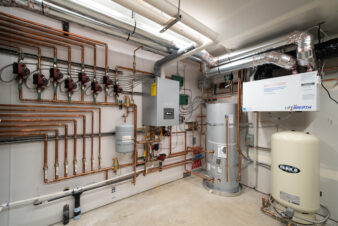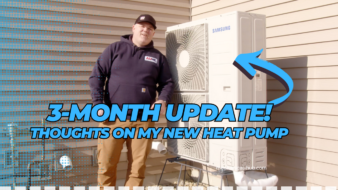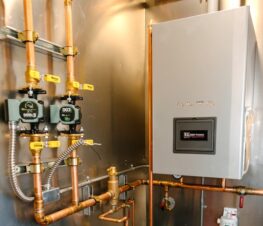Steady Growth Expected in Both Residential and Commercial Sectors
Plumbing and HVAC contractors can look forward to a positive economic climate in 2016, with a continued increase in new residential and commercial construction. Strong sales of existing homes – including a growing number of purchases by move-up buyers – will support the remodeling market. However, an increase in interest rates, tight credit conditions may make it more difficult to finance expensive projects, and the 2016 presidential election and the threat of global terrorism remain wild cards for the U.S. economy.
“Across the country, builders can sell anything they construct,” said Lawrence Yun, chief economist, National Association of Realtors (NAR). “Demand for new homes exceeds supply, and it’s likely that many builders will be ramping up production in 2016.”
The National Association of Home Builders (NAHB) also forecasts strong growth in the New Year with 1,255,000 housing starts in 2016, up from 1,119,000 in 2015. That includes 877,000 new single-family homes and 378,000 new multifamily starts. As for home sales, the NAHB predicts 642,000 new single-family sales and 4,664,000 existing-single family sales in the next 12 months.
In a September housing report, NAHB chairman Tom Woods, said “It is encouraging to see new-home sales continue to tick upward. Builders are also increasing their inventory even as they face difficulties accessing lots and labor.”
Regionally, sales for the month rose 20.5 percent in the West and 4.5 percent in the South. Sales fell 28.6 percent in the Northeast and 8.6 percent in the Midwest. The inventory of new homes for sale was 232,000 units in November, a 5.7-month supply.
Looking at 2016 existing single-family and condominium sales, Yun says, “Move-up buying activity will be particularly strong. With rising values, owners will have more equity to purchase a more expensive home,”
However, a critical issue for many homeowners – as well as businesses – is the availability financing to pay for new projects. The Federal Reserve’s decision to raise rates in December for the first time in a decade will have a ripple effect upwards on both mortgage loans and construction lending. The NAHB projects that a typical fixed-rate 30-year residential mortgage will go up from 3.88 percent in 2015 to 4.55 percent in 2016.
“The Federal Reserve’s decision to raise short-term rates is the first of many increases over the next couple of years,” said Yun. “Although this first move will likely have minimal impact on mortgage rates, additional hikes will push borrowing costs to around 4.50 percent by the end of next year. With home prices expected to continue rising, wages and new home construction need to start increasing substantially to preserve affordability.”
On the positive side, Yun sees a continued improvement in mortgage availability. He notes that lenders are becoming more comfortable approving mortgage loans for buyers in the middle of the credit score spectrum.
“Since this is a presidential election year, there will be much discussion about tax breaks,” Yun said. While Congressional action is unlikely in 2016, it’s possible that the mortgage interest deduction for second homes or the 1031 property exchange program could be changed in 2017 or beyond.
The commercial sector
Sustained job growth throughout the country and improving credit conditions are expected to support an increase in commercial real estate activity, according to an NAR forecast.
“Temporary turbulence in the financial markets, a stronger U.S. dollar hurting exports and economic weakness overseas chipped away at third quarter growth and led to some deceleration in the pace of commercial investments,” Yun said. “The good news is that these deterrents are slowly residing, which should ultimately reawaken the growing appetite for commercial space heading into 2016.”
National office vacancy rates are forecast to decrease 0.8 percent to 14.8 percent in the coming year as continued job creation drives demand. The vacancy rate for industrial space is expected to decline 1.4 percent to 9.7 percent, and retail availability to decrease 1.3 percent to 11.3 percent, according to NAR.
With new apartment construction projects coming through the pipeline in several markets, multifamily vacancies are forecast to increase over the next year, from 6.1 percent to 7.3 percent.
Regionally, several states in the South and West have outperformed the rest of the country in job growth over the past year. Led by strong demand for apartments from faster household formation and rent growth, metro areas in those states are expected to see elevated levels of new construction, which will lead to a slight uptick in vacancy rates.
“The best days for multifamily housing could be winding down as new construction has already surpassed historical averages,” adds Yun. “This sector has been the industry’s top performer over the past several years as a result of younger households struggling to become homeowners and the demand for apartments far exceeding supply in many markets.”
Remodeling market may soften
Remodeling projects and home additions are an important part of the day-to-day business for many plumbing, heating and HVAC contractors – especially in states with stable or declining populations. In that regard, a third-quarter survey by the National Association of the Remodeling Industry (NARI) found a softening in this market sector.
The most recent NARI Remodeling Business Pulse (RBP) data of current and future remodeling business conditions stood at 6.03 (above 5 indicates growth), a decline from the 6.48 recorded in June. While still positive, this rating points to slower growth in the months ahead. The NARI study showed:
- Number of inquiries was down 4.6 percent
- Requests for bids was down 4.0 percent
- Conversion of bids to jobs was unchanged
- Value of jobs was down 4.6 percent
“Remodelers are becoming more realistic and accepting of the slow growth other economic indicators are confirming,” said David Merrick, chairman of the NARI Strategic Planning & Research Committee. “We are adjusting to slow sustainable growth and are less optimistic. Our customers are being careful about budgeting and taking on bigger projects, so leads may be down a little, but the leads we are getting are more focused and on target and budget oriented.”
However, about 53 percent of remodelers in the survey expected business growth in the coming months, compared with only 15 percent seeing any level of decline.
A new generation of owners
One of the key trends of 2016 and the years ahead is the arrival of the Millennial generation. Now in their 20s and 30s, these young adults will be buying homes, launching entrepreneurial businesses and playing an increasingly greater role in the U.S. economy.
“Young adults, who make up the majority of all renter households, are typically more optimistic about their future,” said Yun. “As more of them settle down and begin plans to start a family, the allure of owning their own home as well as the long-term financial stability homeownership provides will drive their emergence into the housing market. However, the extent to how fast this occurs will greatly depend on more entry-level housing supply coming onto the market and needed improvements in affordability conditions.”




Join the conversation: